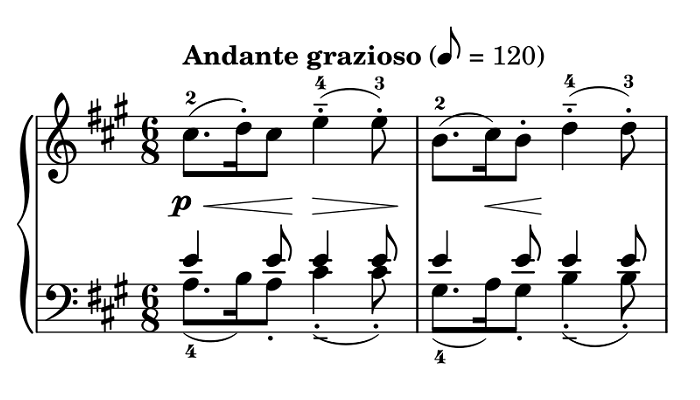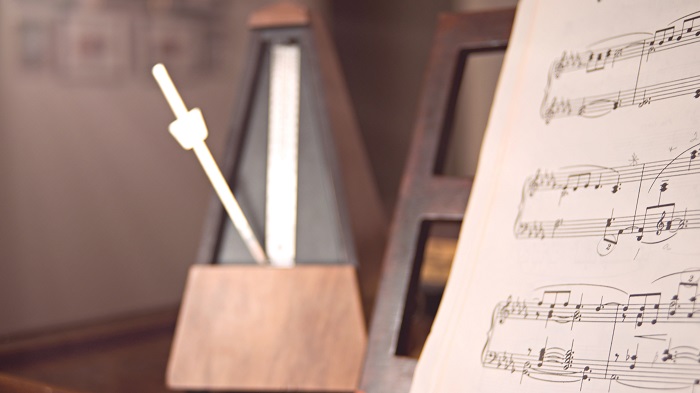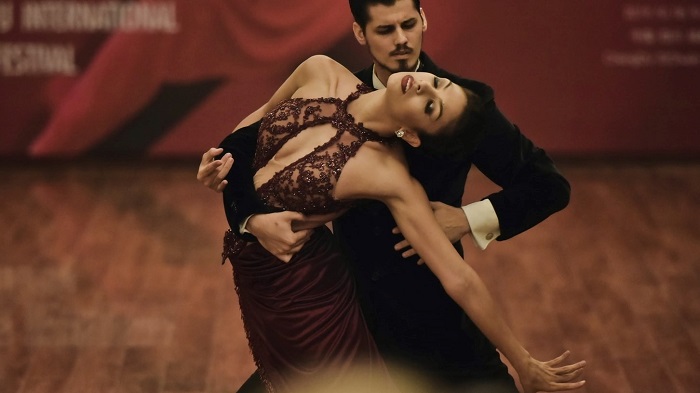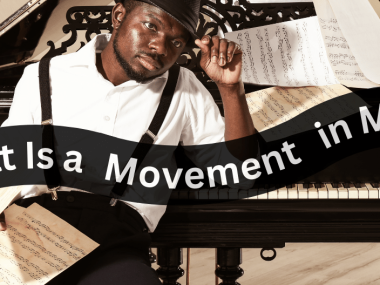Have you ever wondered how musicians know how fast or how slow to play their music? And here’s an even bigger question: how do they give the notes mood and expression?
Simply stated, by varying the tempo of a particular segment. The best example of that is the music of jaws; where there’s a tap, then a steady build-up that creates an immense amount of suspense. That escalation is ultimately an increase in the music speed.
Andante is one of several tempo markings that musicians have been using since the Renaissance.
What Does Andante Translate to?

Andante is an Italian word that generally means “slow down”, but things are not that simple. Sometimes, it means “slow down as you stroll under the moonlight” or “slow down and be mellow”. Other times, it implies “slow down to breathe after a vicious fight”.
That’s exactly why robots and some skilled musicians can’t really play music. There’s a huge part that depends on personal experience. It’s about the unique interpretation of what the composer might have intended.
To further demonstrate, we can take a look at one of Anton Bruckner’s markings: “Bewegt, quasi Andante, feierlich”. This German/Italian note translates roughly to ‘Vivacious, semi Andante, Stately’.
Vague as it might be, these tempo instructions are certainly more intuitive than Bach’s notes. Since these often come with minimal tempo or articulation signatures.
In a famous concert in the 1960s, Leonard Bernstein explains how Glenn Gould could interpret Bach’s notes without the essential composer instructions. This shows both the importance of tempo signatures and the unbelievable talent of Gould.
So What Exactly Does an Andante Tempo Mean?
The tempo of a music piece denotes how fast or how slow it should be played. This isn’t left entirely to the judgment of the players, as there are ways to identify and unify the concept of the ‘beat’. Tempo is expressed as beats per minute, and it’s best represented by the metronome.
The Andante tempo resembles your heartbeat when you’re walking briskly. It’s like the music of Bach’s Air, Beethoven’s Moonlight Sonata, and the amazing Italian song Bella Ciao.
To understand how fast an Andante movement should be, we should look at a few more things. Like the other speeds frequently used, alternative ways of timing a music piece, and the finest pieces that were played in the Andante tempo. Additionally, there’s the matter of why these speed marks are given in Italian?
Why Are the Tempo Marks Written in Italian?
Between the 14th and 17th centuries, Italy was experiencing its glorious Renaissance. Every aspect of life was changing, but most of all, the arts and culture flourished incredibly. At the same time, the rest of the world was struggling with internal and external conflicts.
Italy soon became a magnet for musicians, painters, and thinkers from the four corners of the map. In addition to the emergence of many great Italian artists that became mentors for others. That’s why much of the vocabulary of music and art is in Italian.
The abundance of Italian terminology was accompanied later on by French, German, and English terms. Even today, it’s not surprising at all to see instructions written in two or more languages on the same music sheet.
What Are the Other Speeds Commonly Used in Music?

In order to read music, one has to know how quickly or how slowly it needs to be played. Just imagine playing a song like Someday in a fast tempo, or going too slow with Drunken Sailor. Clearly, it would lose its meaning, mood, or punch.
Thus far, we’ve only talked about the Andante tempo, but there are plenty more where that came from. Here are the basic ones.
- Larghissimo: This is an incredibly slow pace, like a heart beating at 24 bpm.
- Largo: This isn’t just slow, it’s also ‘big’, like a military march. It follows a tempo of 40–60 bpm
- Adagio: This too is slow, but it’s a bit dramatic. It has a slightly higher tempo of 66–76 bpm
- Andante: This is the regular walking step at which our heart would beat at 76–108 bpm.
- Moderato: Here the pace gains a bit of spring, and the beats rise to 108–120 bpm.
- Allegro: This is a quick and optimistic stride. It’s full of energy at 120–156 bpm.
- Vivace: Still quick, but also lively and vivacious. Imagine a race with a tempo of 156–176 bpm.
- Presto: This is an extremely fast tempo that’s way higher than any heartbeat. 168–200 bpm is what machines do, and surprisingly, music has even faster tempos.
Are There Other Ways to Time Music?
The very first timekeeper was an invention by Abbas Ibn Firnas in the ninth century. Galileo added to it a pendulum action but didn’t associate it with music. This prototype was carried to completion in 1814 by Dietrich Nikolaus Winkel.
Another engineer, Johann Maelzel, adopted that model and started manufacturing it under his own name. To avoid appearing to steal the invention, Maelzel added a scale to the metronome. He then set out to market it to musicians, performers, and choreographers.
Beethoven was among the first to embrace this new invention, and all his published works from 1815 onwards were marked by beats per minute.

Besides the metronome, some music composers resorted to assigning a total time for the whole piece. And from there, the performers should figure out the suitable tempo.
I personally find that a bit more complicated than just revealing the proper timing from the outset. Surprisingly, Bella Bartok and other musicians were applauded for that new convention!
Nowadays, metronomes are no longer mechanical structures, and most people use electronic contraptions. There are many mobile apps that simulate the look and sound of vintage mechanical metronomes. I’ve used some of them, and they’re amazing.
Who Sets the Tone/Tempo of a Music Piece?
A musical composition could be written in strict terms, where the tempo is given in clear beats per minute. But still, someone has to keep that beat, and the rest of the players need to follow. Otherwise, if every player decides to take matters into their own hands, the piece would be a jumble of asynchronous tunes.
Typically, the conductor, or maestro, is the person who’s often in charge of maintaining the right tempo. This is among many other tasks, of course. And if a music player strays a little, you can often spot the conductor dragging them back into the right tempo.
In music bands where there’s no formal conductor, it’s customary for the drummer to keep the beat.
Andante in the Tempos of Classical vs. Modern Music?
Dance Music for Palaces

Back in the day, beats were used primarily for composing music. Some of that music was intended for chambers or orchestral concerts, and these could come in any kind of tempos.
Other types of music were designed specifically for ballroom dances. They had to have a tight structure that suited the movement of the dancers.
Choreography went hand in hand with composition at the time. All the Waltzes, Boleros, Tangos, and Polkas are of this type.
By the time Opera and singing were celebrated arts, the tempo had to follow the human way of talking. Music couldn’t be too fast for the words or the vocals of the performers. That’s why Andante is a popular tempo for many of these pieces.
Matching the Beat of The Previous Song
In our modern times, the tempo is still one of the main pillars of music composition, and the beat still plays a huge part in more parts of our life.
There are some interesting applications that started appearing around the 1960s, and they had to do with beat. As clubbing and dancing in public venues became a thing, DJing as a profession grew too. And to keep the dancers from leaving the floor, the DJs invented a trick.
Beatmatching was the new development Francis Grasso brought to the pop scene. It meant merging the beats of two songs, so the dancers wouldn’t notice that one ended and another began.
Matching the Energy of the Room

In recent times, DJs took this game a step higher, and they started matching the tunes to the heartbeats of the dancers. If the energy of the room is regular, and people are just chatting, then a song with a beat from 70 to 90 should be good. And by the way, that’s an Andante.
As the energy rises, so does the beat. And the songs still match the room’s heart. But that can’t last for too long, or the crowds will just escape back to their chairs. That’s why a good DJ would give breathers, pick up the beat again until the night ends on the softest of tunes.
From Dancing to Sports
Beatmatching isn’t limited to clubs, and DJs weren’t the only folks who noticed how music affected energy. Many gyms soon caught up with the idea, and tunes specially tailored for high-intensity training emerged en masse.
Another way the beats are used is relatively new. Some smartwatches and fitness trackers are capable of matching a person’s heartbeat with a suitable techno song. You might’ve guessed that a nice walk would invite Andante music, and as the heat goes up, the beat goes up.







